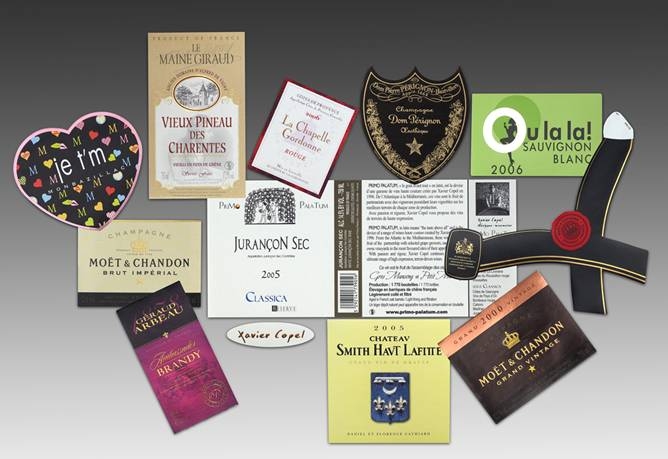Autajon, founded in 1965 by the father of current CEO Gérard Autajon, has made a name for itself in pharmaceutical and cosmetics packaging. Its head office is in Montélimar, France but the company has branches through Europe and one in the US. Fifteen percent of Autajon’s business is dedicated to wine and spirits labelling, with printing sites in Bordeaux, Burgundy, Loire Valley, Côtes du Rhône, among others. In 2009, the company projects a turnover of €400m. Alain Courbière is the sales director of wine packaging.
When we started the wine and spirit packaging division [in 2002] we were very well positioned, because we knew about the different marketing developments that went on in perfume marketing, such as the soft touch effects and the colour effects. Knowing that business helped give us a leg up on wine packaging. For instance, we were the first ones to develop a varnish that is used for Braille. That had never been done. That was one of the innovations that we transposed onto wine labels that gives a definition and feel to it. We have a ‘soft touch’ varnish that can be made of velvet, tissue, leather or wood and used on the wine label and that is something we transposed from the perfume industry. Also the holographic effects.
Today the company has 17 designers and more than 5,000 wine clients, almost all of whom are in France. Some are based in France, but are part of an Australian or Californian wine group, such as Pernod Ricard or Foster’s. In general, we act as more of a technical consultant to the big groups than a creative agency, because they have very strict technical and aesthetic rules, so we’re mostly technical and production. When it comes to our wine clients, there is not a major difference between the French and the Anglo Saxons, because we have a very diverse base of clients. Some of them look for a very traditional French label and others want something new. What we’ll do is go to a given market, go to the agent or importer and work with hand-in-hand with them. The importers know their market and so are in the best position to know what works, rather than us doing a market study.
Knowing what works
We don’t go to a winemaker and tell them they have to change for the sake of changing. We keep what works best in the traditional market and add value by enlarging it, to enrich their product offer. We never know what will work, so while we do look at consumer trends, what we find works better is to look at consumer moments. We find those moments – those times where the consumer is enjoying the wine – and create a label that better fits that particular moment of drinking. While we look at consumer trends, what we find works better is looking at the ‘consumer moment’.
The means of consuming has changed. Traditionally, for instance, the French consumed wine at dinner, perhaps a family dinner on Sunday night. Today wine may be drunk at other times – perhaps around a swimming pool. So the moments are changing and you formulate the creativity of the label depending on that moment, whether it’s a happy moment or a traditional moment. So a swimming pool wine is a convivial wine. It’s a moment with friends in the sunshine and that gives it an emotional impact. Such a wine does not have to be a moderately priced one – you can have Champagne in this moment.
We do 15-20m wine labels for Moet & Chandon. In the Champagne and bubbly world, everything is directed towards festive moments and celebration. It’s also linked to elite moments. So we can learn a lot from Champagne, because there are other wines you can drink in elite and festive moments. The difference is that there are certain behavioural codes linked to Champagne, while there are far more behavioral codes attached to the other different types of wine that make them more complex than Champagne. The behavioural codes are wide and varied.
Before you can begin creating the label, you have to understand the final use of the wine. This has to start with the quality of the wine, but it also has to reflect the moment. A ‘pool’ wine can have a bit of acidity, a bit of fruitiness and be for a moment that’s festive. The wine inside has to evoke a certain use or energy, and the label is the ambassador of the wine when you’re not there.
Big changes
One of the major revolutions in the wine business in France has been learning how to sell wine. They have a very good knowledge base and knowhow about producing wine, but it used to be that people would simply come and buy it. But now they have to sell, so they need a large variety destined for different consumers. That’s a major revolution for the French wine industry and that’s where the whole idea of altering or changing the packaging to fit different consumer positioning comes from.
When you speak to the French vintners who don’t change, they’re often the Grand Cru Classé. They base their experience on history and so when they work on their wine label they change it in little salami slices. Then there is a new generation, the Coca Cola and TV generation that have been nurtured on marketing visuals. This movement started in the 1980s, but the major wave came in the year 2000.
The major error we see is the vintner or wine maker creating a label that he personally is pleased with. He likes it and he thinks it’s right for the market, without taking the target market into consideration. There are a lot of people like that. One winemaker brought in a crayon picture that his son, who is in kindergarten, had done. He wanted to make it into a label, but we talked him out of it. Such a conversation is more human relations than anything else. If he had wanted to make a micro cuvee to dedicate to his son, that would be fine, but the winemaker cannot always take his own emotions about the wine into consideration.
There are generally two different scenarios with clients. If they want to have a traditional French image to present to their export market, then there are no questions to be asked. But if you want different labels for different labels for different export countries, then we draw on our treasure trove of marketing knowledge. In our client base, we have 5,000 clients and a lot of experience. With such experience come many success stories that we can dig into. However, there is no simple recipe for the export market, because specific success stories can’t be duplicated. For instance, we do the label Fat Bastard, but we wouldn’t try a ‘Fat Pig’ in a different market.
We don’t often have financial case studies, because clients won’t tell us if our labels or packaging solutions have changed their bottom lines, because they don’t want their labels going up in price. But we do know when something works really well, because they buy a whole lot more from us and our sales increase, or they ask us to develop the same technology on other brands.
Final thoughts
In France at least there are 40,000 winemakers all of a certain size, from small to large. Compare that to the spirits market, with five companies in France, while there are maybe 20 or 25 in perfume. Many of them belong to large groups and can do the marketing studies and research that goes into creating aesthetic advertising. The other problem with wine is that it’s difficult in France to advertise.
The major thing that the wine business can learn from the perfume industry is probably the branding, creating a strong brand. In France, this will probably mean collective action. On the one hand it’s a good thing, because if you collectively get together you can pump a lot of time and effort into creating a strong brand. The bad thing is that if you manage eventually to galvanize opinion of a large group of winemakers in going into a certain direction it also has the possibility of erasing the unique elements of wines made in France, by standardising them.
As told to Felicity Carter
This first appeared in Meininger’s Wine Business International in 2009.




